Praetorians
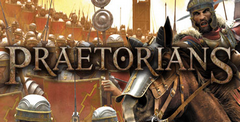
| a game by | Pyro Studios S.L. |
| Platform: | PC (2003) |
| User Rating: | 7.5/10 - 11 votes |
| Rate this game: | |
| See also: | Download Strategy Games, Best RTS Games, Games Like Stronghold |
Of all the empires to have straddled this globe, it is perhaps the Roman that is the most widely admired. Having given such advancements to this nation as running water, a straight road from London to Peterborough and all-night orgies, there’s much to thank our ancient Italian imperialist cousins for. Of course, the fact that those of our ancestors that weren't fed to the lions ended up hand-feeding grapes to lardy landowners as house slaves tends to get obscured in our rose-tinted recollection.
Regardless, joining the list of bounties bequeathed to us by Pax Romana, although somewhat belatedly, comes Praetorians, a nice little tactical RTS from the same Spanish developers who brought us the Commandos series. A game all the more timely given the unveiling of the fantastic-looking Rome: Total War from the makers of Medieval and Shogun, due out hopefully at the end of this year. The question is. has Praetorians ambushed Creative Assembly's latest project, defeating it even before it could reach the field of battle? Or has the announcement of the latest Total War meant that Praetorians' reign will be a mighty short one? Only careful reading of the following four pages will tell. That or a quick look at the verdict box at the end.
Military Matters
Praetorians, like Medieval before it, does away with traditional RTS resource gathering, and arrays your troops into permanently fixed formations. There’s no need to constantly research new technologies to tip the battle in your favour, and you don’t have to worry about picking berries and mining iron, leaving you free to fret solely about military affairs. Which, in our book, is no bad thing.
The 20-odd mission campaign is like a whirlwind tour of the ancient known world. Starting out in Gaul where the local tribes are getting restless, it’s soon on through Belgium and into Britain for a battle or two. Next up is Germany, home of many a ferocious barbarian tribe, and then on to the Middle East and North Africa before returning for a climactic showdown in Rome itself. There are three distinct forces represented in the game, the Romans, the Gauls and the Egyptians, and you get to command troops from each of them along the way.
Viewfinder General
The viewpoint in Praetorians is somewhere between isometric 2D and full 3D. You can raise or lower the angle of the camera which works as a basic, but somewhat throw-away zoom function, and the direction the camera faces is always fixed. For the most part, this works fine, as it prevents the confusion that a fully 3D engine can create. But on occasions, such as when you want to rotate and see where the ladders are on the other side of a wall, it can feel a little constricted.
Your troops are organised into units of anything between 16 and 40 or so men. You can divide a formation into two, combine two smaller ones, or balance the numbers between two of differing strength.
Supporting these larger formations are a number of specialised units. In every mission you will have at least one commander, useful for recruiting new soldiers in villages as well as bestowing a combat bonus on nearby troops. Physicians and druids are also on hand to heal the wounded, and scouts are there to keep an eye out for the enemy. And, lest we forget, a small variety of siege engines and primitive artillery such as catapults can be called upon. But more on this later.
The Village People
As mentioned earlier, there is no resource gathering in Praetorians, which is not to say that there are no resources. In fact, almost every mission (as well as multiplayer encounters and skirmish battles) revolves around a number of villages. Once a village is captured and garrisoned, you can use it to recruit new formations. Units take differing amounts of time to assemble and some also require you to spend 'honour points’ you have acquired in battle.
While this recruitment reduces the population of the village, it slowly regenerates, in effect meaning each offers an inexhaustible amount of men. The problem is, if your enemy has more or bigger villages than you, then he will be reinforcing quicker, so you’ll need to engineer a decisive battle to tip the scales. It’s a novel way to approach matters in an RTS, although slightly reminiscent of Z: Steel Soldier’s 'the more you conquer the more reinforcements you generate’ approach.
There’ll come a time when you need some siege ladders, a catapult or two, or even a bridge being rebuilt, which is where your auxiliaries come in. These troops function on one level as basic infantry. But it’s in their role as combat engineers that they really excel. With a small amount of battlefield DIY, some of the number from a unit of auxiliaries (or their Gaullic and Egyptian equivalents) can be turned over to the construction of siege weapons, as well as defensive towers and bndges.
Moral High Ground
Terrain is all-important in Praetorians, for line of sight and for combat modifiers. The maps are effectively 'two storey’, meaning there's ground level and high ground. All high ground is somewhat unrealistically walled off by cliffs, apart from certain access points. Troops on high ground can see down, but those below them can't see up. Those with the benefit of elevation can also fire arrows further and to more deadly effect, and those defending at close quarters receive a combat bonus. All of which means, possession of the high ground is paramount, as is scouting out the hilltops you don't own with your eagle scouts (see Boy Scouts boxout).
Wooded terrain poses a similar problem. Units outside of forests cannot see in, and even if they wanted to, many such as cavalry, spearmen and siege engines cannot venture in at all. And what with the Gaullic propensity for concealing large numbers of troops in the trees, you're going to have to check out every sizeable wood for danger before your troops can pass by safely. Or send in the wolf scout (again, see boxout).
All of which means that simply advancing through unfriendly terrain blindly is a really bad idea, placing an onus on reconnaissance. Bowmen on higher ground, and ambushing clumps of Gaul berserkers hidden in the woods make any rash advances costly, believe us.
Imperial Leathering
On the visual front, Praetorians does its job admirably and to a relatively low spec. Trees gently sway, rain and snow fall, deer graze, birds burst from trees when troops pass below - it’s not mind-blowing by any means, but it more than suffices. It only really lets itself down when the battles get larger, as clashing formations seem to condense into tight balls of screaming combatants, meaning you can’t tell friend from foe, let alone who’s winning.
By eschewing non-military matters such as resource gathering and research, a big emphasis is placed on the battles being sufficiently spectacular and tactically absorbing to keep you satisfied. Which is probably where it falls short of being up there with the classics of the genre. All the units in Praetorians have specific jobs, and many require more than a little micromangement to wring the best out of them. Spearmen are deadly in defence against cavalry, but you have to click a button to put them into stationary mode first, creating a wall of raised spears. Legionnaires can advance practically impervious to archery using the turtle formation button, but they fight less effectively like this, so you have to unclick it when they approach their target.
Safety In Numbers
Getting used to each unit’s strengths and weaknesses is an enjoyable experience, but after a solid day 's play, piecing together each mission's tactical jigsaw becomes a little repetitive. The presence of unit-generating villages means these become the focus of any strategy, as he who owns the most villages wins.
To increase the challenge as you progress, Praetorians falls back on making the maps bigger and your enemies more numerous. Which leads to a number of problems. Not only do you lose sight of where everyone is and what they were supposed to be doing, but even keeping your forces in any sort of formation becomes nigh on impossible. Battles soon become unruly wars of brawling attntion. And this has the double knock on of you not being able to correctly micromanage your troops, as well as you losing the aesthetic and tactical pleasure of watching opposing armies in tight formations, clashing in spectacular style as you do in Medieval.
The upshot is that those addicted to the Medieval style of martial splendour and battlefield finesse will feel disappointed with the slightly strategy-lite style of Praetorians. But the flipside is that those who find Medieval a little heavy and prefer something a little more pacey and intuitive will find much to enjoy here. Which is one of a number of reasons why we think Praetonans deserves a good score. Even if it is looking over its shoulder at Rome: Total War.
We’re Seasoned Campaigners - So Where’s The Dynamism?
We're all familiar with the many campaigns of the Romans as they set about converting most of Western Europe and the Mediterranean to red wine and mid-meal puking. From the painful conquest of Gaul, to the campaigns in the Holy Land, it was as much the alliances and manoeuvring made off the battlefield as the bloodletting on it that gave them their success. And you can’t help but want to be involved on this kind of strategic level, deciding where the next battle will be, and on what terrain you will choose to fight. But here missions chop and change from Britain, to Turkey and back again, with you getting no choice in what comes next. The campaign structure is that of an arcade game -you finish one level and qualify for the next. OK, so it needn’t have been as comprehensive as Medieval, but a little dynamism in the campaign structure would have been nice.
Download Praetorians

System requirements:
- PC compatible
- Operating systems: Windows 10/Windows 8/Windows 7/2000/Vista/WinXP
Game Reviews
"Praetorians will set a new benchmark in strategy-based PC games," claims Nick Earl, VP for development for Eidos US. Like we’ve never heard that one before, but in the case of Pyro Studios’ Praetorians, we’re inclined to think he might have a point. This 3D RTS title from the makers of the Commandos series focuses on the political machinations of the emerging Roman Empire, and players will get the opportunity to command the forces of not only the Romans, but also the religiously fanatical Egyptians and the ferocious Gauls.
What immediately sets Praetorians apart from the bulk of RTS titles, is that in the 'to dig or not to dig’ dilemma, the game has gone for the lesser 'not to dig’ option with a distinct lack of any resource management. Instead, like Shogun, it’s played purely as a tactical war sim. Then there are fortress sieges and assaults. That’s a whole new area of gamepley that’s only starting to be touched by recent RTS games. The fortresses in Praetorians are huge and intimidating, but in gameplay terms the real innovation is to turn fortress walls into actual battlefields, i Deploying your forces from an assault tower is quite a sight, as is seeing vour tower crumble to ashes under the flames of defenders’s fire arrows.
In the battle of the RTSs next year, Praetorians is undoubtedly bringing up the 'Shogun with Romans’ side and it looks as though it will be taking Age Of Mythology on in a head-to-head battle for the hearts and minds of strategy enthusiasts everywhere.
Now that the big guns of realtime strategy - Westwood and Ensemble Studios, responsible for C&C and Age Of Empires respectively - have both embraced 3D graphics, can we now proclaim the sprite-based 2D graphics engine dead? I for one sincerely hope not, but you have to admit, we haven’t seen a killer isometric game for some time, despite the unending popularity of sprite-based graphics in games like The Sims. Never fear, say I, Praetorians is almost here.
"Hang on there Shoemaker," you interject, "If you look closely you’ll see Praetorians is actually a 3D game." Oh, and you can tell, can you? "Oh yes," I hear you say, "look at the little men running around, they seem to be made up of straight lines, suggesting they are thoughtfully constructed out of hundreds of thousands of little computer generated triangle-shaped sticklebricks." Well... yes, that does seem to be the case. "Ergo, Mr Maker of Shoes, 3D!"
3d Or Not 3d...?
Well, yes and no. While Praetorians looks utterly 3D and indeed is, it doesn’t actually play in 3D. For instance you can't spin the camera, nor can you zoom in or out on the countless dozens of troops. In fact, like C&C, you’re stuck with the same view -except of course that your legions of Romans, Egyptians or Barbarians, move about as naturally as they might in the most realistic first-person shooter. It’s a curious thing to actually create a stunning-looking 3D game and not allow those that play it to swoop through it like an uncle at a wedding wielding a new camcorder. Why so?
"We wanted the game to feel familiar to people," says Inigo Vinos of Pyro Studios. "Which is why we have a fixed perspective. Because of the engine, however, we can zoom in for cut-scenes and show the individual faces on the characters, which will drive the story forward."
The storyline is important, in that although the campaign is a linear one, you play throughout the rise and fall of the Roman Empire, controlling each of the game's three races in turn. Moreover, the battles themselves are based on real events, one for instance has you guiding a small Roman detachment through the mountains to outflank a barbarian army - perhaps the first ever documented use of Special Forces behind enemy lines.
Skilled Labour
Rather than dragging boxes around your troops, Praetorians' troops are pre-grouped, Shogun-style, with you being able to split formations up as and when you see fit. Of course there are the usual gamut of soldiers, from those on horse and camel, to archers and infantry, but rather than employ the tired paper-scissors-stone formula, each unit has a sting in the tail, a secondary skill if you will.
For example, Roman heavy infantry can form into the famous tortoise formation and use javelins as short-ranged weapons. There are some highly original units as well; rather than have scouts, armies can employ men with hawks on their arms that can be launched skywards to seek out the enemy. Then there are the commanders that can recruit and train soldiers from local villages under your control. Best of all you can use engineers to push huge siege towers into place, drive battering rams into city gates or storm the walls with ladders. Watching the game in action it has to be said it is a wonderfully animated game, easily on a par with the recent Battle Realms. If the game underneath ends up being half as good as the graphics, we are in for a real treat indeed.
Robbie left Take That, Geri expelled herself from the Spice Girls and now the square-jawed creator of the Commandos series, Gonzo Suarez, has packed up his pencils and vacated the offices of Spain's most prolific games developer, along with seven of his most trusted allies.
You would have thought such a mass departure would spell doom for one of Europe's most respected games studios. After all, the last great high-profile exodus from a games developer saw a similarly sized squad of talent leave Ion Storm - and we all know what happened to Daikatana as a result. This time things are different we’re told. Gonzo and his fellow escapees from Camp Pyro worked solely on Commandos and left only when the recent console conversion was complete. If any game's going to suffer, it's the third in the classic WWII series, due some time next year. Praetorians, it seems, is safe. "It is fairly common for some people to move on to other endeavours after finishing a project, so from the point of view of Pyro Studios, eight people leaving is not an issue," says Javier Arevalo, project leader on Praetorians. "They had no involvement in Praetorians and from a more personal perspective, I'm very happy for them. I hope they are very successful in their new challenge." That's that sorted out then.
Rome Sweet Rome
Having spent the six years of its short history wrapped up in World War II, Praetorians is quite a departure for the Madrid developer. It’s set during the most turbulent times of the Roman Empire, a period when imperial expansion was rampant, Egyptian power was on the wane and turmoil was mounting from within. At first glance the game appears a more traditional real-time strategy game compared to the Commandos trilogy. Rather than a handful of specialist soldiers, Praetorians will allow players the opportunity to control thousands of Roman, Egyptian and Barbarian troops, across 3D battlefields set as far apart as North Africa, Britannia and Central Europe. Rather than sneaking behind enemy lines, the aim is simply to push them further back, by raining down arrows on the enemy ranks, charging them with your finest warriors and seizing their strongholds with the help of ladders, towers and catapults.
"Ancient times have something that makes them extremely attractive as a setting," says Arevalo. "From a gaming perspective, there’s a lot of inspiration to be found in massive armies and epic military campaigns, without the need to resort to alternate realities with wizards, dragons and other fantasy creatures. We wanted to do a full-scale strategy game inspired by historical reality."
Formative Peers
Of course, there’s no shortage of strategy games on PC that take inspiration from ancient history, but where Praetorians differs from the likes of Civilization, Age Of Empires and Caesar III is that it centres its al attentions on the art of destruction rather than economic development. Housing villagers, setting up trade routes and developing new technologies is completely off the menu, but if the thought of not being able to set tax rates or send your peasants off to chop wood worries you, be assured that when it comes to the field of battle, Praetorians is way ahead of the competition.
Unlike most strategy units come ready-grouped into squads of 30 men, which can in turn be split into two groups of 15. With well over a thousand tiny men in skirts parading across a map at any one time, it makes a lot of sense that they are. In similar fashion to Shogun and Medieval, this means that if you click on a soldier, the entire unit he belongs to comes into play. Unlike more traditional RTS games, you’re not forced to drag a box around individual men and fiddle with shortcuts to get them to do anything meaningful.
Because of this streamlined approach to army management, much more thought has gone into tactics and formations - a feature that has been sorely lacking from Roman-themed games in the past, especially considering that this is what the legions of Rome were famous for.
"During pre-production of the game we did a lot of research on ancient armies to see how they actually fought," says Arevalo. "We were amazed at the amount of tactics and procedures that the Romans developed to manage their huge armies. This was the main driving force behind the personalities we have given to the three different civilisations; Romans, Barbarians and Egyptians."
Three Tribes Go To War
The differences between the three sides are much more than just cosmetic. The Romans, being more organised and highly trained, can be ordered into a number of varied formations to maximise their impact. Archers can be lined up into a slow-moving but effective firing formation, with the front ranks kneeling to allow those behind a clear field of fire. Legionnaires can make use of the infamous 'turtle’ formation, essentially a human tank with shields covering every flank, making the unit virtually invulnerable to attack from other infantry.
By comparison, the Barbarians, a general amalgamation of Gaul, Celt and Germanic tribes, are completely different, being strong, fast and prone to rushing in en masse. Whereas Roman leaders can make use of a number of special formations, the Barbarian chief can employ skirmish tactics, or simply command his troops to shout a lot as they rush into the fray. The Egyptians are, as you would expect, somewhere between the two extremes, with perhaps a greater emphasis on ranged and cavalry combat.
Tidy Little Unit
Apart from the different sides and the tactics that they specialise in, Praetorians also introduces a number of unique and interesting units. The backbone of any army is its rank and file grunts, but in Praetorians they also double a to es or fotress.
Scout units are particularly distinct from what we’re used to. Instead of going through the palaver of guiding a lone cavalry unit across the map to lift the fog of war, you have scouts that are accompanied by animals that can be used to scope out the land ahead. Clearly inspired by the cinematic classic Beastmaster, scouts can either release a trained hawk to spy from above, or a wolf that will pad into the forest and sniff out an ambush hiding within. Though we’re dubious as to whether such methods were actually employed, the inclusion of such units is sure to make for an original experience. We're willing to let historical accuracy slide on this one.
Graphicus Maximus
Graphically, of course, Praetorians looks splendid, perhaps not as wildly attractive as Battle Realms or as detailed as the imminent Age Of Mythology, but far more impressive in terms of landscape and the sheer numbers of soldiers that the 3D engine can handle. Lines of troops wheel around the meandering tracks like finely drilled soldiers on parade, and if you care to order a group of engineers to build a siege ladder, they'll hunch over its construction, pick it up when complete and carry it to the front line through massed ranks of infantry - who'll actually shuffle out of the way to boot.
Though relatively small, the maps are tightly packed with dangerous forests, scarred with rocks and awash was beautifully flowing water. March across a stream and your troops will leave ripples in their wake. Take them though the forest and wildlife will scatter, with deer taking flight and birds flitting into the sky. Apart from looking superb, such actions have an important bearing on the action - if you see branches swaying and birds suddenly taking to the sky, you can bet the enemy are in there somewhere waiting for you to stroll by.
Perhaps most impressive of all are the siege battles. Instruct a unit of men to enter a siege tower and they won’t just suddenly disappear off the map, but visibly climb aboard, while other soldiers push the wooden tower towards the enemy ramparts. If they make it, gangplanks are let down and the soldiers pour out to engage the enemy on the battlements. It’s painstaking details such as this, seemingly insignificant on the face of it, that look set to ensure that the game captures your imagination.
Village People
Although the battles are the cornerstone on which Praetorians has been built, Pyro hasn’t completely done away witfi the concept of resource management. Rather than gold, iron or food, generals simply have to look after their supply of troops, which means sallying forth and securing a local village from which to recruit fresh blood. Each village is home to around 200 people, and by building a garrison on the outskirts of town and sending your Centurion in to take over, you can bleed the population dry by press-ganging every able-bodied man into service. Auxiliary Infantry, the mainstay of your force, are relatively quick to train, while pikemen, archers, legionnaires and praetorian guardsman can take at least three times longer to train up.
It’s a shame however that Pyro couldn’t see their original vision through. Ideas touted back when the game was first announced included horses as well as soldiers. To create cavalry units you had to find and train wild horses, or perhaps even massacre them to keep your enemy from making use of them. There was also a feature planned whereby you could take enemy prisoners and either conscript them into your front line force or use them, quite literally, as cannon fodder.
"I think these features were distracting from the real core of the Praetorians gameplay so we removed them," says Arevalo. "We toyed with the idea of adding some naval elements too, but they felt too artificial somehow and in the end we decided to abandon them completely." The words expansion and pack spring immediately to mind.
The Rise Of Rome
Though Praetorians perhaps lacks the scope of the Total War series, the prospect of another game on a similar scale, yet with smoothly animated 3D units, impressive ease of use and tactical opportunities that even Medieval lacked is certainly one worth savouring. But Javier Arevalo thinks Praetorians has still more up its sleeve: "The initial perception of the game is that of a classic RTS, with intuitive interface and control system," he says. "But once you start to play the missions you quickly notice that the gameplay experience is radically different. Our novel approach to resource management and the effect of terrain features in the approach to battles creates a wholly new type of game. Many strategy gamers will recognise stuff that they have always wanted to do in other RTS games but never could. Couple this with the very attractive historical setting and the powerful graphics engine that allows us to portray the terrain and units with great detail, and you have a game that I believe most strategy gamers will enjoy from beginning to end."
A New Perspective
A 3d Strategy Game Where You Don’t Have To Fight The Camera... Could It Be True?
There are many who shy away from 3D strategy games, generally because you have to battle with the interface just as fiercely as the enemy. Few 3D RTS games have managed to get the balance right, and no matter how good the interface, none have ever matched the simplicity offered by 2D or isometric games like Red Alert. Praetorians, despite being in full 3D, is very much a 2D game in terms of the control method, since the camera is fixed in one direction. Far from being restrictive, it actually makes the game far easier to get to grips with and has the added benefit of offering very detailed terrain, probably because your graphics card doesn’t have to keep working out where to put everything every five milliseconds.
Of course this is no great innovation - Warcraft III and Age Of Mythology employ similar systems, as will the forthcoming SimCity 4. Of the big RTS franchises then, only C&C is yet to come to the party, and we’ve yet to see how the camera in Generals ends up. Still, it seems clear that 3D fixed perspective is the way ahead.
Concerning the second thing that the Romans were famous for, and not in fact being the official 3D version of Sim Orgy, Praetorians is a 3D RTS set amid the trials and tribulations of the emerging Roman Empire. But in a climate where RTS players have gorged themselves to bursting point on historical strategy fare along the lines of Shogun, Age Of Kings and Cossacks, will Praetorians be the wafer thin mint which has us coating the walls?
Praetorians' project leader Javier Arevalo certainly thinks so."We believe that focusing on combat and bringing these kinds of innovations really sets Praetorians apart. Special unit abilities and formations such as the Roman TUrtle or the Gaul war cries, emphasise the combat-oriented gameplay style, and the player will have die chance to drive fortress sieges using a variety of war machines such as assault towers or battering rams."
The good news for those that would rather concentrate their efforts on troop juggling than crop rotation, is that Praetorians contains very little resource management, and instead is much more focused on the military strategy aspect, using a number of actual Roman campaigns as the inspiration behind a number of the missions. "Our goal is to emphasise troop control and strategic decisions in combat situations," says Arevalo.
"In this context, making a complex resource model would conflict with our style of gameplay, because it would shift focus to building bigger armies faster."
As far as camera angles go, Pyro have sensibly decided to opt for a fixed camera angle which ideally will help the player evaluate the terrain, stay focused and keep track of their attack and defence plans. However, the game uses a full 3D engine in order to reflect the complexity of terrain and unit animations, which together provide some impressive visuals.
Following in the upstanding tradition of three-sided warfare, the big three in Praetorians are the disciplined Romans, the raw strength of the Gauls (undoubtedly caused by falling into the magic potion when they were babies) and the Egyptians, who use a combination of religious fanaticism and science to complement their range of military units.
Your military units are arranged and controlled in troop formations, although some specific types of units are individual by nature, with special purposes like exploration or technology, rather than direct combat. You will be given a specific army to begin with, and you'll need to recruit additional troops all through the mission and also work out a way to prevent the enemy from doing the same. As you progress through the campaigns, new abilities and technologies will become available, and within an individual mission there will be several ways of improving the abilities and performance of troops in combat.
But as with most RTS games, it is the AI of your troops that can make or break the entire gameplay experience. Too many of us have wept over our keyboards as our perfectly honed army were cut to shreds because they decided to take a short cut straight through the middle of the enemy's base. "The AI evaluates and makes use of the most appropriate unit abilities depending on the balance of their forces and the enemy they're facing," claims Arevalo. "It also recognises the importance of villages, terrain and ambush spots. Additionally, we can fine-tune the specific details for each mission's flow of goals and sub-goals, thanks to our scripting engine."
The excesses of the ancient Romans are legendary -especially its leaders. Give any centurion several tables of meat and wine, surround them with small boys and you can bet that by the morning he would have devoured the lot and still be fresh-faced and ready for battle at the crack of dawn. Just as long as the local governor gets his taxes and the indigenous barbarians are kept at bay, a Roman commander could live in idyllic over-indulgence, indefinitely. Mess things up though, and it's off to the most desolate and uncultured place in the Empire - Britain.
As far as Roman provinces went, Spain was something of a safe seat. Neither desolate nor uncultured, Spain - or to be precise, Madrid - is also where Pyro Studios, the developers of Praetorians, work, rest and play. And rather than bless this sceptred isle, the company asked a load of journalists to Madrid in order to cop a look at what it's been working on besides Commandos 2. We accepted.
Praetorians looks to the untrained eye like Age Of Empires would if it was in spin-o-rama 3D. In fact it looks better than Age Of Empires in fancy 3D. It looks better than almost any 3D strategy game you'd care to mention. Unlike AOE however, Praetorians is a man's strategy game; none of that sheep-farming, wood chopping girly stuff you get in other games, oh no. The only resources in Praetorians are of the fleshy variety: soldiers, slaves and horses. Find wild horses and you can train your infantry to ride them, take a few enemy prisoners and you can order them to 'take point' - very sharp points in uncomfortable places - or push your siege towers into position up a fortress wall. In response, the enemy can even take your soldiers prisoner and put them to work as human shields, then you can liberate them, or let them rot if you like.
Mission-based, Praetorians starts in linear fashion with players in command of a small garrison of Romans on the edge of the Empire. As you progress and bump into new civilisations, you can either stick with the Romans, or defect. The idea, as Pyro co-founder Javier Perez explains, is: "To expand the single-player game to feel like a multiplayer game, but with a story linking the missions."
Yet to be incorporated are the nighttime missions. Traditionally, night missions in most games just mean more of the same, except darker.
In Praetorians, darkness is a whole new type of warfare, where giving soldiers torches can make them a target for a concealed archer, although, without light your troops may panic, especially if the enemy is skulking around waiting to slit a couple of throats.
With a good few months until its release, there is still a long way to go until the game is complete. What you can't see in these pictures is just how watchable the game is. All the soldiers are in 3D (unlike the forthcoming Shogun: Total War) and they are all superbly animated. Units within formation move realistically just out of sync. Centurions fan out and engage the enemy when disembarking from siege towers and war galleys, and walls even crumble realistically when hit with boulders. God knows what it'll look like when units find themselves under a downpour of boiling oil, but if what was on show in Madrid is anything to go by, it'll be spectacular.
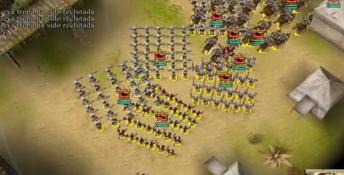

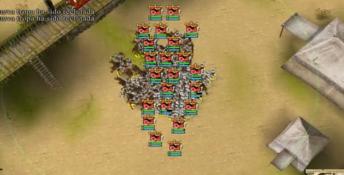
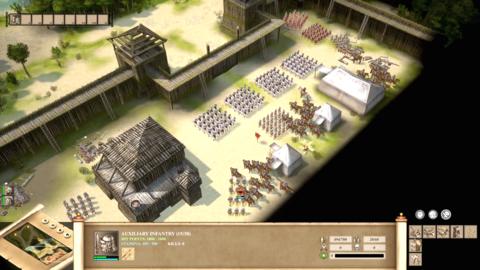


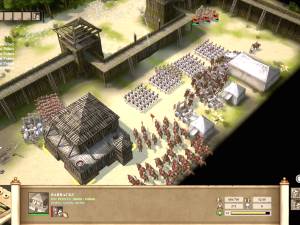
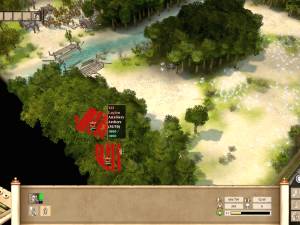
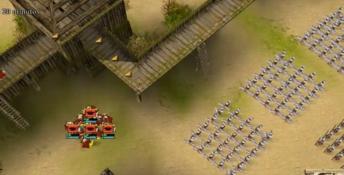
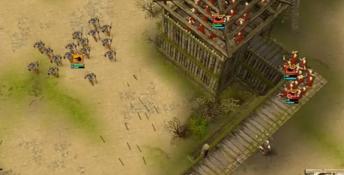
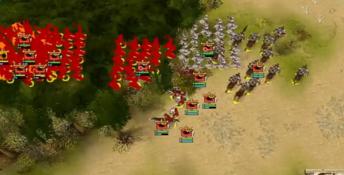
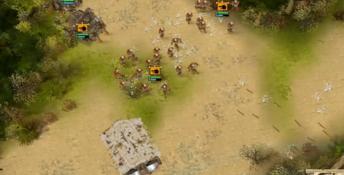

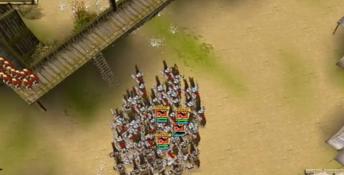


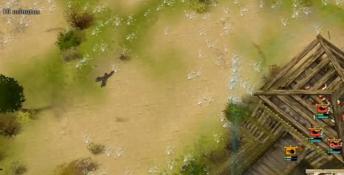
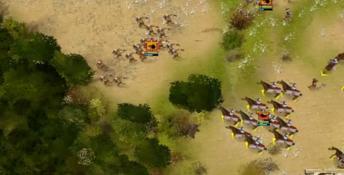

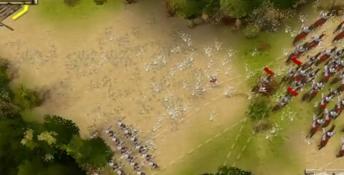
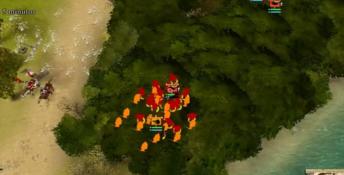
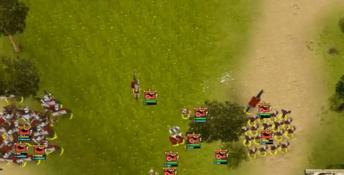
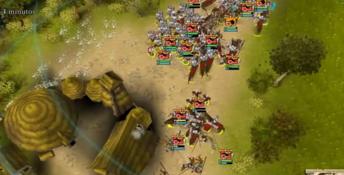
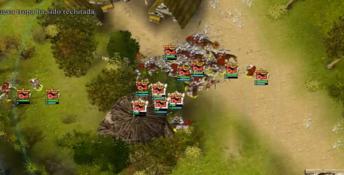
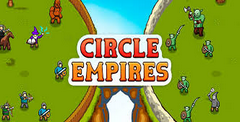 Circle Empires
Circle Empires
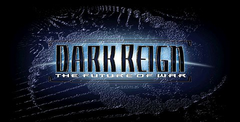 Dark Reign: The Future of War
Dark Reign: The Future of War
 Empire Earth 3
Empire Earth 3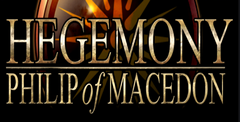 Hegemony: Philip of Macedon
Hegemony: Philip of Macedon Northgard
Northgard
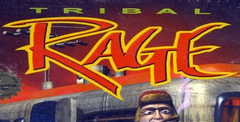 Tribal Rage
Tribal Rage